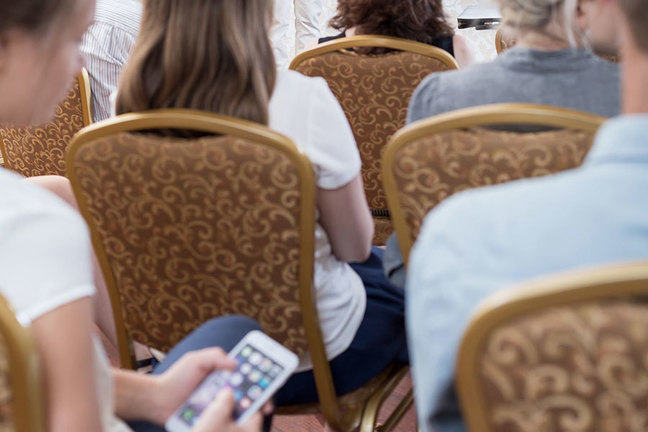Giving your audience an opportunity to give you feedback in real time is a great way to engage them in your presentation.
You can use a range of free and commercial software to do this, such as Facebook and Twitter or bespoke apps made using sites like EventMobiand Noodle Live. These platforms are a great tool for gauging reactions and gathering feedback or questions in real time and are used widely at conferences, shows and exhibitions.

Selecting a unique hashtag. Firstly, select a hashtag, such as #FLcomms16, for your presentation or event. Make sure it’s unique, short and easy to remember so that it’s possible to identify tweets relating to your presentation. Communicate your hashtag to those who have signed up for your event by posting it on agendas, invitations and presentation slides. Use it consistently across all social media platforms.
Use social media to inform the audience. Announce any schedule changes or give practical advice about the logistics around the presentation: parking, directions to the conference room, where to find good food, etc. Before your presentation use your hashtag to share news and views about the topic. This will build a relationship of trust with your audience.
Use social media for crowdsourcing. The term crowdsourcing refers to the process of gaining information and ideas about a topic by asking a large number of people. In advance of an event or a particular talk, organisers and speakers can engage attendees in conversations to generate suggestions and requests and ensure that the content and format of presentations meet their expectations. After your presentation, solicit feedback and questions from attendees. This is a good opportunity to gain insights which you can use to improve future presentations and to make new contacts.
Soliciting tweets during your presentation. At the beginning of your presentation, encourage the audience to tweet their comments and questions. While you won’t be able to follow these in real time, you could ask a colleague to monitor the tweets and pass on any questions at an agreed time. This strategy saves time, as Twitter’s character limit forces participants to keep their questions short and can encourage everyone to participate, even those watching online.
Twitter also allows attendees to engage in conversations about the information and issues raised by your presentation. These comments can be collected and archived for future use.
Poll your audience. Ask the audience to answer a question or short questionnaire where the outcomes appear immediately for everyone to see. This is a powerful device to engage the audience. If your presentation is accessed by a remote audience, they can take part too. You could create a poll on social media sites or use a specific tool, such as Poll everywhere.
Distributing your slides. Make it easy for attendees to find the presentation slides and encourage them to share them on their own social media accounts.
Collecting feedback. Applications such as Survey Monkey and Smart Survey allow you to create customised questionnaires that you can distribute to your attendees. Their answers can be collated in the form of diagrams.
Remember that it’s not always appropriate to invite your audience to engage with social media, for example, if the subject of your presentation is confidential.
Share your own experiences of engaging with social media during presentations.
Source: © The Open University